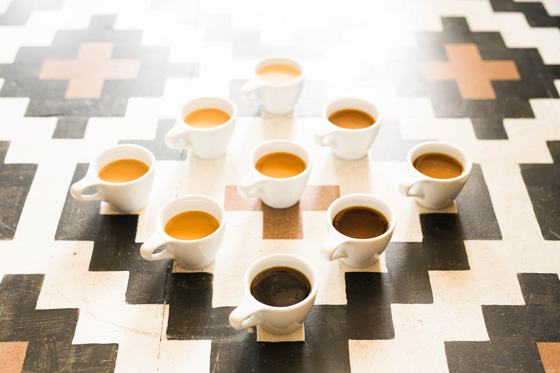Guest authors C. Brandon Ogbunugafor and Rafael F. Guerrero demystify higher order epistasis through a short story about the perfect brew.
Epistasis is the flavor of the month
Epistasis is one of the most popular and provocative topics in modern genetics.
It has many different definitions, but one especially useful one is that epistasis is the “surprise at the phenotype when mutations are combined, given the constituent mutations’ individual effects (1).” In particular, “higher-order epistasis” is intriguing, because it involves interactions between more than two genes or mutations. This concept challenges the notion that genes or mutations operate in isolation and proposes that complex phenotypes derive from multiway interactions among genetic components.
While higher-order epistasis is a challenging idea to think about, related concepts manifest in everyday life. In an effort to demystify higher-order epistasis, we introduce a primer based on the results of a new study published in GENETICS. In that study, a team of scientists measured the higher-order epistasis operating on a protein associated with antibiotic resistance. We found that the amount of epistasis is profoundly influenced by the presence of mutations in other parts of the genome (2).
Here we have re-cast the data into a fictional short story about factors that interact to affect properties of coffee. In doing so, we explain what higher-order epistasis is and how it works by discussing it in a relatable context.
Louise and Lourdes’s search for the ideal cup of coffee
Louise and Lourdes, two coffee connoisseurs in a remote town, have decided to open their own coffee shop. While a few already exist, many have suggested that the town could use a café that takes the craft of coffee-making more seriously. Most of the existing coffee shops use a mix of random ingredients, and the consensus is that the results are mediocre at best. Convinced that they deserve better, Louise and Lourdes set out to explore how to give their fellow citizens a sublime alternative.
Creating a truly exceptional cup of coffee is no easy feat, however. Coffee brewing is a fascinating topic precisely because it is intricate and complex. Preparing a delicious cup is the product of how many different ingredients interact: the coffee bean blend, the type of grind, the method of brewing, the temperature of the water, the addition of sweeteners, creamers, etc.
The town’s grocer offers a rather limited suite of ingredients and getting supplies to their landlocked town is both time-consuming and expensive. Consequently, they have decided to work within their constraints: they will use ingredients that they can produce themselves and items that are available in the town grocery store.
LL Café: your evidence-based caffeine solution
Before opening “LL Café,” they decide to investigate how their available ingredients contribute to the taste of coffee. That is, more than simply identifying how to make the best cup of coffee, they want to understand how the individual ingredients interact with each other.
Specifically, they want to measure how ingredients contribute to (1) the acidity of coffee and (2) the intensity (strength) of the coffee.
They decide to test these two traits independently, because these are two different aspects of what makes an ideal coffee cup: coffee can vary in acidity (a key component of taste), but also in strength (functionally how “awake” it makes you).
Before doing so, they identify the set of ingredients and objects that they have access to. They find that they have variations of the following:
Coffee beans
Both Louise and Lourdes own small patches of land where they grow crops, and each has tried their hand at growing coffee beans. The town grocery store only offers a single house blend of coffee, a mix of whichever beans are cheapest at the time (which explains the mediocrity and lack of diversity in existing coffee shops). Lourdes and Louise decide to try two single-origin beans: Nigerian (Louise’s; a smooth Coffea robusta varietal) and Colombian (Lourdes’s; a classic C. arabica).
In summary, Louise and Lourdes decide to use three different coffee bean types: (a) House blend, (b) Nigerian beans, and (c) Colombian beans.
Brewing method
While there are many different possible ways to brew a cup of coffee, Louise and Lourdes are sticking with what is familiar to them. Louise tends to use a pour-over instrument. Lourdes owns both a French press and a coffee percolator. Rather than attempt to use a new method, they decide to start their experiment by testing these existing methods.
This means that Louise and Lourdes are using three different brewing methods: (a) Pour-over, (b) French press, and (c) percolator.
Combinations of additives
Coffee connoisseurs differ in opinions on whether coffee additives are appropriate, and which additives work best with which coffee types. The limited options in the town help simplify this problem, as there is only a single type of milk, and a single type of sugar. To spice things up, they’ve decided to also evaluate cinnamon, which some people really enjoy in their coffee. Importantly, the additives in the coffee can co-occur in one cup in various combinations. This is unlike the coffee beans and brewing method: it is challenging to brew a cup of coffee that was produced with both a French press and a percolator, for example. Similarly, they would prefer to not brew a cup of coffee from a mix of their different coffee beans (Nigerian and Colombian), as they want to understand how each coffee varietal tastes on its own.
This means that Louise and Lourdes are testing three different additives—cinnamon, milk, and sugar—in all of their possible combinations. This equates to eight different possible combinations of additives:
| Coffee additive combinations | |
| 1) no additives | 5) no cinnamon, +milk, +sugar |
| 2) no cinnamon, no milk, +sugar | 6) +cinnamon, no milk, +sugar |
| 3) no cinnamon, +milk, no sugar | 7) +cinnamon, no milk, +sugar |
| 4) +cinnamon, no milk, no sugar | 8) +cinnamon, +milk, +sugar |
Table 1. Combinations of coffee additives
Louise and Lourdes begin to realize that this experiment will not be simple. They have a total of eight different additive combinations that can each be added to three different coffee blends (house, Nigerian, Colombian), each of which can be brewed one of three different ways (pour-over, French press, percolator). This means that 72 total cups of coffee will need to be prepared. And from these 72, they will need to evaluate both the acidity and intensity. As this new coffee shop venture is important to them, they decide that it is definitely worth their time to perform this experiment responsibly (e.g. with replication).
The results
Louise and Lourdes prepare all 72 cups (in replicate) and carefully taste each. They calculate average scores for acidity (Figure 1) and intensity (Figure 2) for each of the combinations of additives (cinnamon, milk, sugar) across the set of possible brewing methods (Pour-over, French press, Percolator) and coffee blends (House, Nigerian, Colombian).
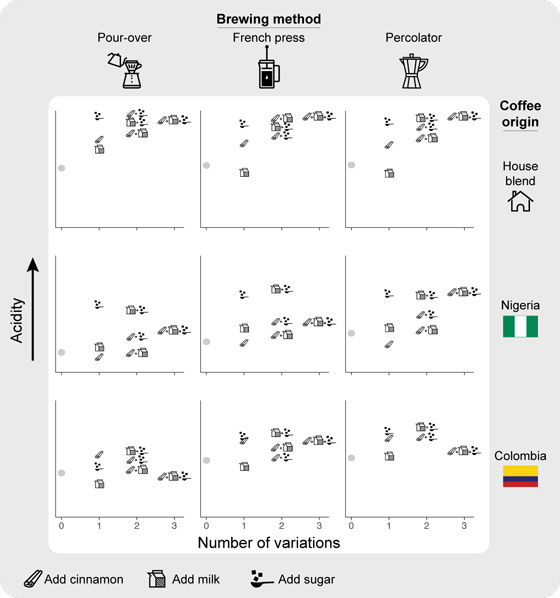
Figure 1. Coffee acidity score for all of the 72 possible coffee cup combinations.
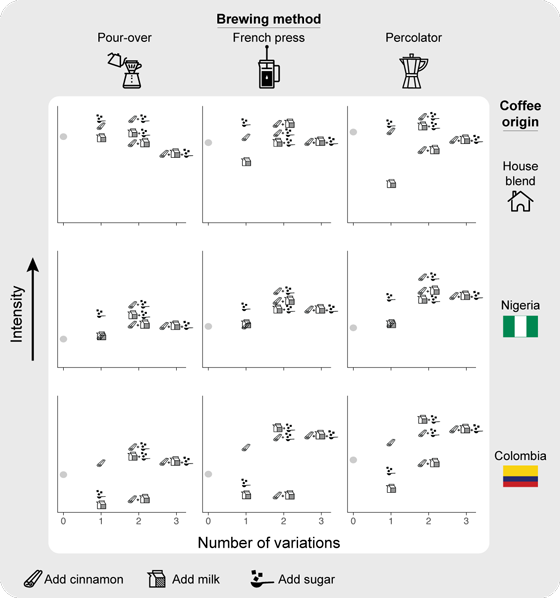
Figure 2. Coffee intensity scores for all of the 72 possible coffee cup combinations.
From Figures 1 and 2, we can summarize some basic observations about whole cups of coffee: maybe surprisingly, the cups containing a combination of cinnamon, milk, and sugar measured with very high acidity scores in both the house and Nigerian coffee blends, when brewed in a percolator. The same cinnamon, milk, and sugar combination was less acidic in the Colombian roast. Even more interestingly, the most acidic mixture in the Colombian roast contained sugar and milk (but no cinnamon). With regards to intensity, the results are different: the combination of cinnamon and sugar had a high intensity across the coffee blends (the highest in house and Nigerian blends).
These results, however, only tell Louise and Lourdes half of the story: they don’t simply want to know which cups of coffee are the most acidic or intense, but rather, to understand how the different components in their coffee system—coffee blend, coffee brewing method, and additive combination—influence these coffee traits (acidity and intensity). In order to do this, they perform a series of statistical tests that are designed to give more detailed information on how individual combinations of different factors contribute to a given coffee trait. Their aim is a representation that captures how the ingredients are interacting in different combinations.
Finally, Lourdes summarizes the results as treemaps (charts in which the area of boxes drawn represents the relative magnitude of factors in their experiment) for acidity (Figure 3) and intensity (Figure 4). Ingredients and their interactions can have positive or negative effects on these coffee traits, so she included a corresponding + or – sign in each box. Lastly, she colored the boxes in different shades of brown to represent the number of ingredients that are contributing to a given effect. The lighter the color brown of the box, the more ingredients are responsible for that effect on the coffee characteristic.
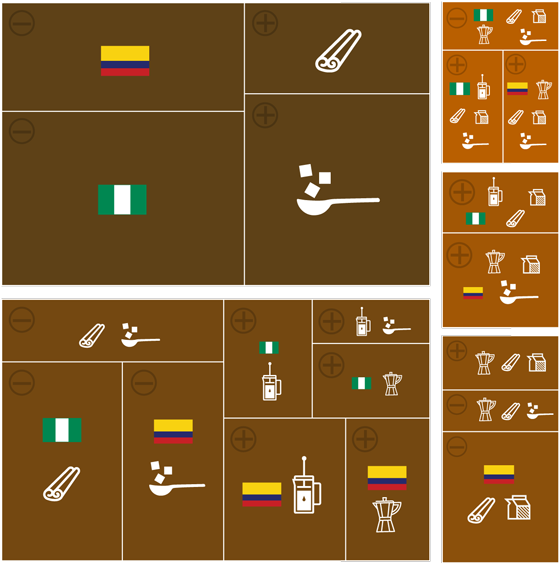
Figure 3. Coffee acidity: interactions between the different coffee factors.
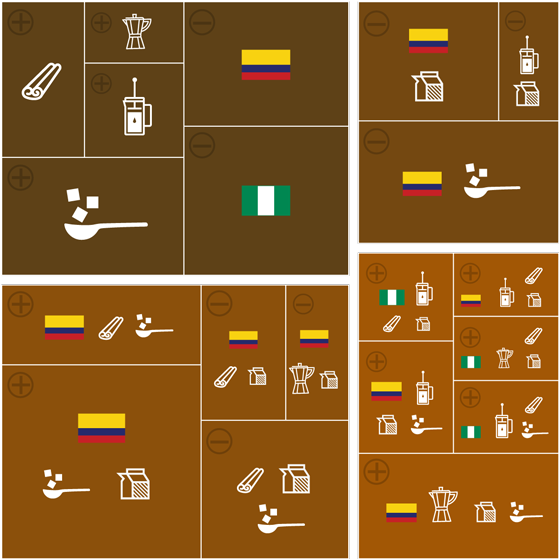
Figure 4. Coffee Intensity: interactions between the different coffee factors.
From Figure 3 Louise and Lourdes could see that the largest single factor (main effect) influencing coffee acidity is its Nigerian origin. That is, of all single factors in the entire study—coffee blend, brewing method, additive combination—the Nigerian coffee blend has the largest single influence on acidity.
Also note that the effect is negative, that is, Nigerian coffee tends to have low acidity. The effect of the Nigerian blend is followed by the effect of the Colombian blend, which also has a negative effect on coffee acidity. These single factors are, however, not the most intriguing aspect of the acidity treemap. What is fascinating is that, in sum, effects involving combinations of two factors (pairwise effects) are more influential than single factors. No single coffee factor or ingredient is responsible for the acidity – it emerges from the interaction of multiple ingredients.
Figure 4 tells Louise an even more intriguing story as it applies to coffee intensity. Of all the boxes in the plot, 3-way interactions seem to be the most important. For example, adding sugar and milk to Colombian coffee has the largest effect of any individual box. And together, 3-way interactions are the most important in defining coffee intensity.
These results are illuminating. Louise and Lourdes reflect on the results and conclude:
Of any single component, the Nigerian and Colombian blends have the largest influence over the acidity and intensity of the coffee. With no other knowledge, one could estimate that a cup of coffee brewed with Nigerian or Colombian beans will be relatively non-acidic and not-very-intense (on average). Assuming that this is the case would be a huge mistake, however: the data also reveal that in order to better estimate how acidic or intense a cup of coffee will be, Louise and Lourdes must know exactly what additives were included, and how that cup was prepared.
For example: even though the Colombian blend is independently associated with low acidity, the combination of Colombian blend prepared with French press or percolator has a strongly positive effect on acidity! This means that the Colombian blends effect is very context-dependent: yes, it tends to decrease acidity, but only under certain circumstances.
This heightened level of understanding gives Louise and Lourdes confidence heading into their coffee shop opening. They are now equipped to handle a range of situations, to appeal to a range of requests:
- “I really like the house blend, but need it prepared in a manner that makes it the strongest.” (Answer: Brewed in a percolator, with cinnamon and sugar)
- “Which single additive is most likely to make a cup of coffee taste acidic?” (Answer: sugar)
- “I want the Colombian blend, and love cinnamon in my coffee: how can you prepare it such that it isn’t very acidic?” (Answer: Brewed in a pour-over, with cinnamon, sugar, and milk)
These types of questions can only be answered because Louise and Lourdes engaged in this rigorous analysis of interactions. It disentangled the higher-order interactions between coffee factors—coffee blends, brewing methods, and additives.
A few weeks later, Louise and Lourdes open LL Café, home to “the most scientific cup of coffee in the world.”
Back to real world genetics
As we mentioned, the data and figures discussed in the story come directly from an actual data set and analysis of mutations in a bacterial protein (2). We also suggest that, while the story is entirely hypothetical, the essential problem that Louise and Lourdes face is not unlike the current challenges facing modern genetics, and the question of how context frames the phenotypic impact of mutations is one that will continue to manifest in many realms. Our hope is that geneticists and citizen-scientists alike can all share in the mystery and intrigue of epistasis, one of the most important ideas in all of science.
CITATIONS
1) Should evolutionary geneticists worry about higher-order epistasis?
Daniel M Weinreich, YinghongLan, C Scott Wylie, Robert B.Heckendorn
Curr Opin Genet Dev. December 2013 23:700–7; https://doi.org/10.1016/j.gde.2013.10.007
2) Proteostasis Environment Shapes Higher-Order Epistasis Operating on Antibiotic Resistance
About the authors:

C. Brandon Ogbunugafor is in the Department of Ecology and Evolutionary Biology at Brown University. Twitter: @big_data_kane

Rafael F. Guerrero is in the Department of Computer Science at Indiana University. Twitter: @guerruhroh


